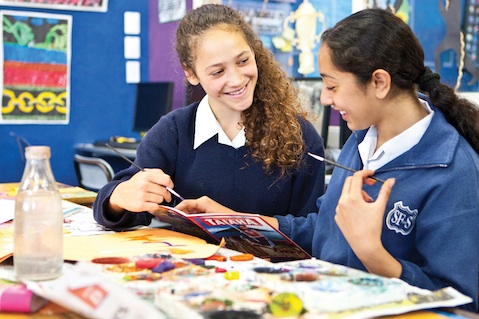Why is learning to learn so important?
Hattie (2009) observes that “significantly high effects on students’ learning are found where they (a) can set challenging and specific goals that allow them to direct, evaluate and redirect their learning, and (b) receive feedback (from peers, teachers, parents, and own experience) that relates specifically to how the gap can be addressed between current and future performance” (as cited in Gibbs and Poskitt, 2010, page 19).
PISA (Programme for International Student Assessment) has found that learners’ belief in their own efficacy is the strongest single predictor of whether they will adopt strategies that make learning effective (Artelt et al., 2003, pages 33–34).
When students can direct their learning and know how they learn best, they can also better navigate the wide range of available choices in school and beyond.
Learning to learn is particularly important when teachers are no longer a main source of information and knowledge. For example, young people regularly use information technologies to connect with other people and information. An individual’s ability to locate and critically appraise information from such sources is vital for learning throughout life.
Whānau and teacher support
Ako (teaching and learning partnerships between teachers and students) promotes shared ownership of and responsibility for learning, with well-known benefits for engagement and achievement.
For example, parent–teacher–student conferences, when the student is well prepared to share their learning portfolio and talk about goals achieved or next steps, can provide important opportunities to enhance the student’s agency in their learning.
Empowering students to become more self-directed learners and helping teachers and parents further develop these skills in their children can significantly increase students’ motivation and achievement in school.
Cleary and Zimmerman, 2004, cited in Gibbs and Poskitt,
2010, page 21
Informal learning conversations between teacher and whānau are another opportunity to build a young person’s agency as he or she shares ideas on setting goals and evaluates his or her progress.
Learning to learn for all
A student’s language, culture, abilities or disabilities, and prior experiences affect how they approach learning to learn. Ensuring that each learner has the language and concepts to set and assess their goals requires the teacher to know that learner and what they bring to classroom learning.
Teacher knowledge of the learner is crucial in supporting Māori and Pasifika learners, and those with special education needs, in learning to learn. Inclusive, supportive classroom environments and learning conversations between teachers, students, and whānau help to support all students in learning to learn.
Albany Senior High School: Learning to learn for life
Albany Senior High School leaders, including principal Barbara Cavanagh and deputy principal Mark Osborne, considered how assessment practices could give effect to the school vision We nurture each other, we inspire each other, we empower each other to achieve highly and become good citizens.
They realised that the school needed more emphasis on student agency within assessment. The school introduced ePortfolios as a way for its students to document and evaluate their learning processes and outcomes.
The ePortfolios are “not simply a shop window”, says Mark Osborne. He observes that “thinking is involved in the process of constructing the ePortfolio, reflecting on it, and cultivating the story and the ideas around [it]”.
Students explore through learner blogs how they learn best, what is going well, what they are finding difficult, and what they can do to support their learning. “When you talk to students, they can really tell you in depth and detail about some of the problems they have come across and what they have had to overcome, and in discussion you can draw out more information,” says Mark.
Social networking through the ePortfolio site allows the school’s students to say “This is my challenge, this is my success; give me feedback on them.”
The ePortfolio system is constantly under review and reflection. As Mark notes, “We are not saying this is the way it should be done. We are learning, we’re on a journey, and this is where we are at so far.”
Source: NZC online
Guiding questions He pātai
- Are all our learners able to take part in establishing their learning goals and evaluating their progress?
- Are there specific and regular opportunities for parents to be active partners in their children’s learning?

